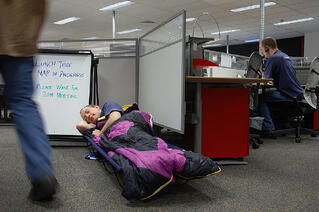♫ Workin' 9 to 5, what a way to make a livin' / Barely gettin' by, it's all takin' and no givin' ♫
If you were alive during the 80s, you now have the Dolly Parton song in your head.
You're welcome.
Did you see the movie? You should, it's a good warning to treat your employees well.
Otherwise they might slip rat poison in your coffee, imprison you in your own mansion, uncover your embezzlement scheme, while enacting flexible working and fair pay policies in your workplace. (See the movie if that sounds insane. Or just read the Wikipedia recap.)
So yeah, be kind.
Back to the song.
Or at least, back to the idea of 9-5.
For decades it's been the standard. Clock in at 9, lunch at noon, clock out at 5. A few 15 minute breaks sprinkled in.
And for decades it's worked well enough. Not everyone operates at their peak early in the morning, but they've usually put in some good productivity before they head out at 5:00.
We said it's worked well enough for decades.
Now we say it might be time to put it to bed.
 Abandoning a rigid schedule to allow employees to adjust when they're in and out of your office could be an attractive corporate perk. The modern workforce desires freedom almost as much as money.
Abandoning a rigid schedule to allow employees to adjust when they're in and out of your office could be an attractive corporate perk. The modern workforce desires freedom almost as much as money.
But there's an even better return on flexible scheduling. What if you could get two or more extra hours of daily productivity from each employee?
It's possible, if you're willing to adjust.
There is science behind our most productive and effective windows. Some people are wired to perform in the morning, while others don’t truly come alive until late in the evening.
Let's take a look.
The Power of When
As children, we learn that certain members of the animal kingdom live on odd schedules. Some are nocturnal and built to hunt and roam at night. Others are diurnal and do their business during the day like us humans.
There may not be such a thing as a true nocturnal human, but science has uncovered that many of us operate on shifted schedules.
We're biologically wired to do so, in fact.
In his book "The Power of When," Dr. Michael Breus outlines four different chronotypes (or internal clock profiles).
- Lions are early to bed and early to rise, and are at their cognitive peaks early in the day.
- Bears need a solid eight hours of sleep, but usually go to bed and rise a bit later than Lions; their cognitive peak is around mid-morning. (Bears comprise the majority of the population.)
- Wolves are night owls who sleep in late, or at least struggle in the mornings. They hit their stride in the evenings.
- Dolphins are light sleepers whose brains never truly shut down. When they sleep, only half of their brain is resting. They're at their best in the middle portion of the day.
(Breus has an online quiz you can use to find your own chronotype here.)
Each of these chronotypes has optimal schedules (this article has a nice illustration of those), with each one having a best time to work, eat, exercise, plan, brainstorm, and so on.
Science says these profiles are hardwired and can't be changed by force. They will change naturally - we tend to be Wolves when we're young (hello Millennials!) and evolve into Lions as we age.
Adjusting the Office for Optimal Work
 None of this mattered in the past, when assembly lines and hard labor were the norm.
None of this mattered in the past, when assembly lines and hard labor were the norm.
Today things are different. Most jobs aren't hard labor, and even frontline retail jobs require people to be on top of their emotional and cognitive games.
Those Millennials that stay up way late and are zombies early in the morning? You can keep beating against that wall, hoping they'll adjust.
Maybe it's worth it to just adjust to them a bit. In an 8-5 schedule you might get two hours of work at their cognitive maximum.
Bring them in from 10-7, however, and now you're getting several hours of their best work.
The same idea applies to other workers.
- Encourage Lions to come in early.
- Try to avoid meetings during people's most productive periods.
- Allow people to get up and move around every once in a while to restore blood flow.
At the very least, have your managers try to understand where their team members stand, and when they're most productive. These changes won't be easy, and in some offices a flexible schedule isn't feasible.
Don't immediately assume you can't do it, however. Many managers fall under the illusion that productivity is best when everyone is present and under a watchful eye.
That used to be true, but it isn't today.
As always, rely on the principles of an effective flex working arrangement.
- Maintain face-to-face contact.
- Ensure there are times when everyone is on duty.
- Design your office so it's always the most attractive and productive space possible.
Sleeping Beauty's Favorite Employee Perk
The best part of adjusting your on-the-clock hours is you can optimize for each individual's most productive periods.
They'll get more done.
They'll be happier.
 They'll stay with the company longer.
They'll stay with the company longer.
The second best part is such an arrangement will quickly become a major differentiator for your company. As you can see from our employee benefits statistics, flexible working arrangements are desired across all generations.
It won't cost you much, either.
Cheap benefits that have a huge payoff are the best, right?
The point of work isn't getting a bunch of stuff done, or even being at a desk.
It's getting the best, most important work done. Period.
Adjusting to employee sleep patterns might help you get eight hours of high output from employees, instead of the typical six.
Even better, it'll keep your sassiest employees from poisoning your coffee and kidnapping you in your own mansion.
That's a good deal.




